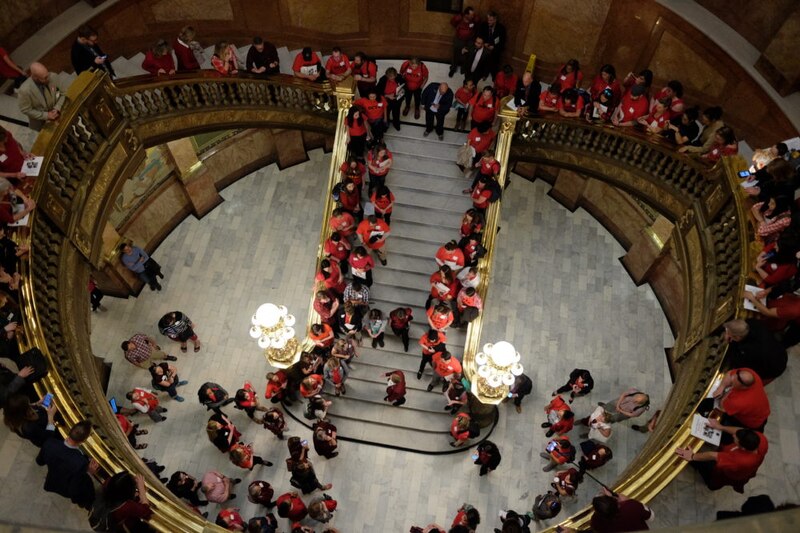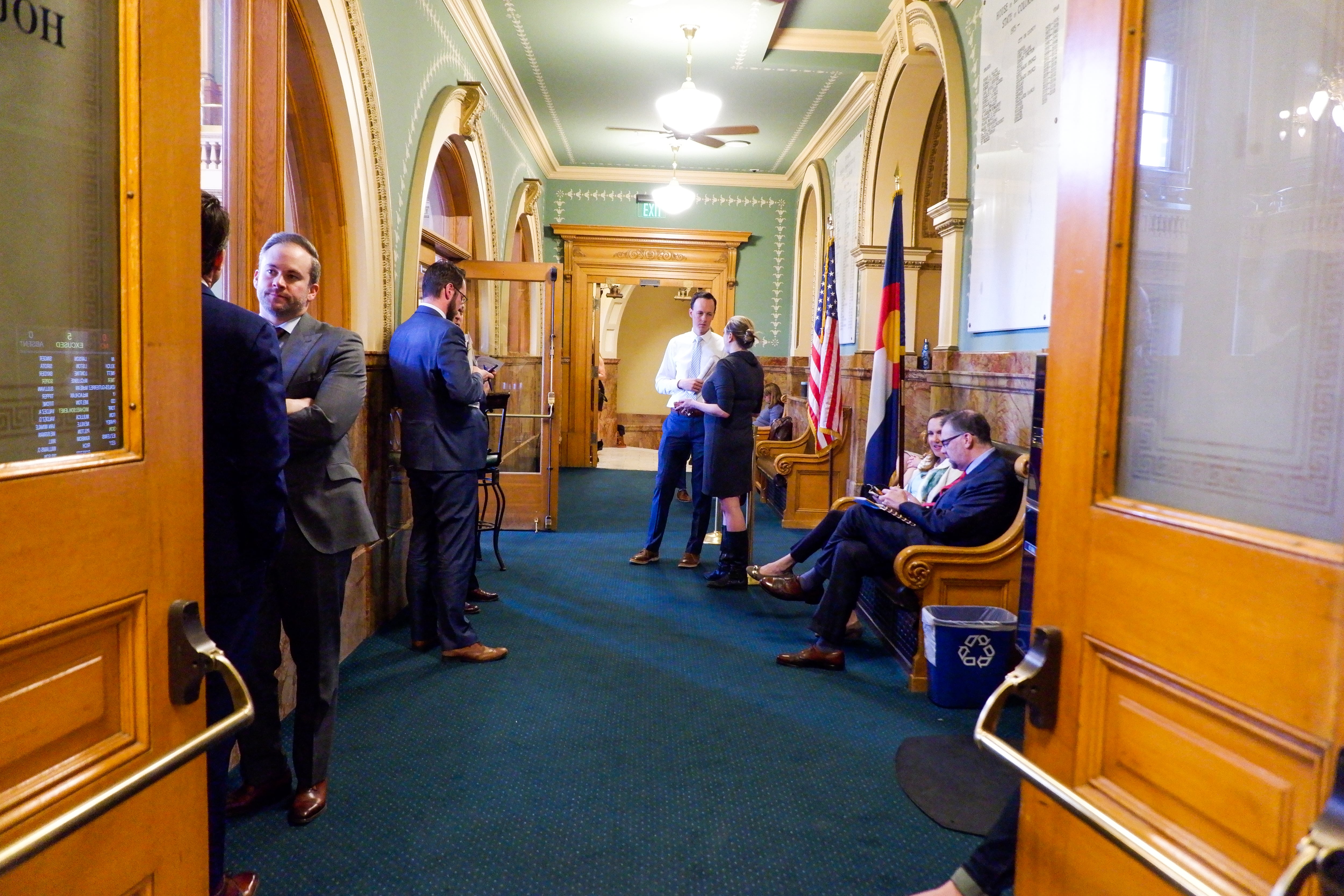When she was a brand-new legislator besieged by lobbyists at the entrance to the Senate floor, state Sen. Rachel Zenzinger felt a tap on the shoulder from a man telling her she was late for her next committee. She rushed to the elevator, and the man accompanied her all the way to the committee room, securing several minutes of one-on-one time to make the case for his client’s bill.
When Zenzinger pushed open the door to the committee hearing room, there was no one else there. The meeting wasn’t even close to starting.
Now that Zenzinger serves as chair of the Senate Education Committee, education lobbyists don’t have to use creative tactics to get her attention. She meets weekly with key players ranging from the Colorado Education Association to Democrats for Education Reform to go over upcoming bills and hear their concerns.
Education interests spent more than $20.5 million to lobby state government from July 2015 through March this year. About half of that came from public universities, school districts, and other government education entities spending public dollars to influence education policy and funding.
Teachers unions and groups representing school administrators, school boards, and rural districts also invested in lobbying the General Assembly. So did private companies and groups representing charter schools and private schools.
Education represents the second largest lobbying interest at the Capitol, though the No. 1 lobbying interest, health care, spends roughly twice as much. There’s a lot at stake: Education — K-12 and higher ed — takes up about 45% of the general fund, yet Colorado still funds education at far lower levels than other states.
In Colorado’s TABOR-constrained fiscal environment, education interests fight for more money but also jockey against each other to snag larger slices of a small pie. In a state that has been at the forefront of education reform and the testing wars, there is also a constant push-and-pull among districts, unions, charters, and advocacy groups over school choice, governance, and the role of high-stakes testing.
And school districts fight hard to preserve local control, pushing back against proposals that parents and advocacy groups hope would improve education but that district leaders see as unfunded mandates that don’t respect their expertise.
“There’s that old saying that, if you’re not at the table, you’re on the menu, so I expect that institutions feel it’s necessary to have a lobbying presence at the Capitol in order to advance their issues,” state Sen. Dominick Moreno, chair of the Joint Budget Committee, said.
Lawmakers of both parties said lobbyists can be helpful by raising new issues, but their input can lead, for better or worse, to watered-down policies, Moreno said.
“I do think that that’s where lobbyists are more effective, perhaps not actively engaging in passing an issue, but in getting the concerns of their clients addressed in legislation,” he said.
Interests focused primarily on preschool through high school spent $12.7 million over the last five-plus years, according to a Chalkbeat/Colorado Sun analysis of lobbying disclosures filed with the Colorado Secretary of State. Those representing higher education groups spent $7.8 million during the same time frame. But several higher education organizations dominate the list of top education spenders on lobbying.
Many education lobbying organizations described their roles similarly: to provide information and help legislators understand the potential impact of the bills they’re working on, to bring up problems their members are experiencing and work to solve them.
Good lobbying, they said, is built on relationships and trust. Things can move quickly at the Capitol, and it’s critical to have someone in the building who knows the issues and knows the players.
“Having someone there who can be responsive at a moment’s notice and also to answer specific questions about charter schools is really valuable,” said Dan Schaller of the Colorado League of Charter Schools, the fourth-largest spender on K-12 lobbying. “We continue to hear a lot of myths and misinformation.”
The organizations that lobby on education issues say they play a vital role in helping policymakers understand how legislation will play out in the classroom. They represent the public interest as they see it.
But parent and community groups say it’s a constant struggle to get their voices heard above those with better access. This matters because who has a seat at the table shapes what bills get passed and ultimately how students are educated.
“These lobbyists are seen as education policy experts, but we as parents have a boots-on-the-ground perspective that the lobbyists don’t have, and that perspective is sometimes drowned out,” said Lindsay Drakos, a member of COKID, a parent organization that wants to see universal dyslexia screening and improvements to reading instruction.
Higher education spends on the budget battle
The biggest spenders on education lobbying are the state’s public colleges and universities, led by the University of Colorado system and the Colorado Community College System.
Without the network of advocacy organizations found in K-12, higher education institutions mostly lobby for themselves — and much of that effort is directed at the Joint Budget Committee.
Tuition costs have skyrocketed at Colorado’s public colleges and universities as repeated state budget cuts shifted costs to families. Unlike K-12, there is no state requirement to fund higher ed, making each year a new fight for scarce dollars.
“State funding and tuition are directly related,” said Todd Saliman, senior vice president for strategy, government relations, and chief financial officer for the University of Colorado system. “And it is our job to explain the connection and tell them what impact their decisions have on students.”
Without the research dollars and out-of-state students that bolster the CU system’s $4.5 billion budget, smaller regional colleges are even more dependent on the state budget and well represented among the top lobbying interests. These schools also depend on lawmakers to fund long-delayed capital projects.
“It’s really a question of diminishing returns because every institution has lobbyists, and they’re all really just kind of advocating for their own slice of the pie,” Moreno said.
But there are also larger issues in play. Zenzinger, who previously served on the Joint Budget Committee, recalls a “very helpful” conversation with a lobbyist for the University of Northern Colorado that eventually led to a new statewide higher ed funding formula. It distributes state money based on the type of students colleges serve rather than just overall enrollment, sending more money to UNC and other regional schools.
This year, higher ed groups are lobbying to make the SAT and ACT optional for college admissions and to grant in-state tuition to Native American students from tribes with historic ties to Colorado.
The community college system has advocated for phasing out remedial education, giving up a source of tuition dollars, because officials believed they had a better way to get students through introductory courses, as well as for the creation of a bachelor’s of science in nursing. It took significant lobbying to explain to lawmakers why the new program was necessary to address a nursing shortage.
Having lobbyists at the Capitol gives public colleges and universities a direct line to lawmakers, a point person who can answer questions or flag problems with a proposal.
“We want legislators to understand the comprehensive role we play in both the academic and career tech ed side,” Colorado Community College System President Joe Garcia said.
K-12 competes on policy and money
The Colorado Education Association, a union representing classroom teachers and other school employees including bus drivers and cafeteria workers, leads the pack on K-12 lobbying.
“Our lobbying numbers are backed by the 39,000 educators who do the day-in, day-out work of educating students. We’re not some corporate hedge fund,” said Amie Baca-Oehlert, president of the CEA. “We’re lifting up the voice of educators so that their voice is represented as policy plays out.”
CEA has a political director and two dedicated lobbyists, their salaries covered by member dues. Not included in their lobbying reports, Baca-Oehlert and Vice President Kevin Vick testify frequently on legislation. CEA also organizes lobbying days in which hundreds of teachers come to Capitol in #RedforEd T-shirts to talk about teacher pay, pension protections, testing, and mental health support for schools.
The union isn’t always successful — members were unhappy with a 2018 compromise to shore up the pension system, and a major revision of the teacher evaluation system hasn’t moved forward — but CEA has blocked efforts to link teacher pay to performance and kept education at the forefront of budget discussions.

Other top spenders include K12 Inc., a for-profit online education company; the Colorado Association of School Executives, which represents district administrators and by extension school districts themselves; the charter league; and the Colorado Department of Education.
State education department spokesperson Dana Smith said every state agency has a legislative liaison that helps lawmakers get information they need from the department and helps staff stay informed about developments at the Capitol. CDE’s legislative liaison is a contract lobbyist, Jennifer Mello, rather than a staff person.
“It’s an incredible amount of work,” Smith said. “We think we get really good value out of hiring someone with expertise and relationships rather than having a dedicated staff person.”
CDE’s lobbyist also represents the State Board of Education, a separately elected body charged with implementing education policy set by the legislature. State Board interests at the Capitol range from updating the state accountability system to reining in the growth of grant programs that cost time and money to administer. When legislators proposed doing away with standardized testing this year, the State Board defended its value.
The Colorado Association of School Executives represents 2,300 school superintendents, principals, business officers, and other administrators. CASE offers training and other resources, but lobbying is a key function.
“If there is a conversation that becomes a bill that becomes a law, our members want to know we were part of the conversation and shaped the outcome,” said Bret Miles, executive director of CASE.
The group argues for more money for education, defends district autonomy, and pushes back against anything it sees as an unfunded mandate. That sometimes places CASE and other groups that represent districts in opposition to legislation aiming to expand services for students or regulate what happens in schools, though Miles said the group tries hard to find compromises.
When CASE members disagree among themselves, the group doesn’t take a formal position.
Schaller of the Colorado League of Charter Schools said his members have similar expectations on the issues that affect them, whether that’s finding buildings, getting a share of money from voter-approved tax increases, or preserving appeal rights when they disagree with a school board decision.
Much of the money that fuels K-12 lobbying ultimately comes from taxpayers. Some superintendents have their CASE dues covered by their districts as part of their contracts, and some charter schools use state-provided operating dollars to pay their charter league dues.
Many large school districts have their own lobbyists, with the suburban Cherry Creek School District, which did not respond to an interview request, leading the pack in spending. School districts also join groups like the Colorado Rural Schools Alliance or the Opportunity Coalition, which represents high-poverty districts, to advocate for their particular interests.
The Cañon City school district in southern Colorado pays about $9,000 a year to belong to three lobbying groups. Superintendent George Welsh said it was initially a hard sell to get his school board to agree. But the dues more than pay for themselves.
The district received $550,000 this year in sustainability dollars — extra funding secured by the Rural Schools Alliance. The Opportunity Coalition, meanwhile, makes sure high-poverty districts get priority for many state education grants.
“If you are able to hire an excellent lobbyist, you are more likely to get things steered your way,” Welsh said.
Denver Public Schools is another top spender among school districts. With the unusual combination of high property wealth, many students in poverty, and a historically close relationship with charter schools, the district sometimes disagrees with positions taken by CASE or finds itself defending unique interests.
For example, Denver is the only district in the state to benefit from an obscure aspect of the 1994 school finance formula, the concentration factor, which increases per-pupil spending for students in poverty by 36% in districts where more than 50,000 students qualify for free lunch.
“Why is that in there? DPS had a damn good lobbyist,” said Anne Barkis, a lobbyist for Denver and the Opportunity Coalition.
How it works
The best represented education interests at the Capitol have regular meetings with lawmakers. Zenzinger meets every Monday with groups that represent districts, school boards, and teachers unions and every Wednesday with advocacy groups that support school choice and school accountability, alongside charter groups and business coalitions interested in education.
They go over upcoming bills and talk about concerns and possible amendments. Zenzinger says she doesn’t put education lobbyists in the same camp with those representing business interests. Instead, she sees them as bringing valuable knowledge from the front lines of education.
When it comes to what can and can’t get passed at the legislature, it can be hard to separate the influence of lobbying from philosophical alignment between legislators and education groups that contribute to candidates.
State Sen. Paul Lundeen, a Monument Republican who often finds himself on the losing side of education policy debates, described CEA as one of the most powerful forces at the Capitol, not because of lobbying, but because they help Democrats maintain their majorities.
“They spend time and money influencing what the body looks like,” he said.
There are also close personal connections between education interests and state government. Saliman, of the CU system, previously served in the legislature. Garcia, of the community college system, is a former lieutenant governor. Mark Ferrandino, until recently a top Denver Public Schools administrator, is a former speaker of the House. Brandon Shaffer, government affairs director for the St. Vrain Valley School District, is a former Senate president. Jennifer Bacon currently serves as both a state representative and a Denver school board member.
All the things that make lobbying work for insiders can make it hard for outsiders to navigate the political process.
“The lobbyists are there every day at the Capitol and they have established relationships with legislators and that is their job and they are paid to do it,” Drakos, of COKID, said. “Just the mere fact that we can’t be there every day puts us at a disadvantage. We have jobs and businesses — and kids who need to be tutored because they’re not getting what they need at school.”
COKID didn’t start out with a lobbyist. They now have pro bono representation from Sewald Hanfling, a helpful free benefit, but not the same as a full-time advocate. Almost four years after they first pitched lawmakers on the idea of universal screening for dyslexia, something that exists in more than 30 other states, legislation still hasn’t been introduced.
Keri Smith, a representative of Padres & Jóvenes Unidos, which works with parents and students of color in Denver and other districts, said that for many years, the group’s ideas about school discipline reform were not welcome at the Capitol.
The group has had legislative successes, including expanding free breakfast and lunch and ending zero tolerance policies, but it still doesn’t get the kind of standing meetings that more established groups do.
And when Padres pivoted into emergency response mode to help their families through the pandemic, they lost ground at the legislature just by not being as present, Smith said. Their major priority this year — a school discipline overhaul — collapsed in the face of fierce opposition from law enforcement and concern from some districts and education groups.
“Nobody is reaching out to community organizations to have those power-building conversations,” Smith said. “They want our community there for testimony, for quotes, but when it comes to sitting at the decision-making table, it is a hard fought battle.”
This story was reported as a collaboration between Chalkbeat and the Colorado Sun.







